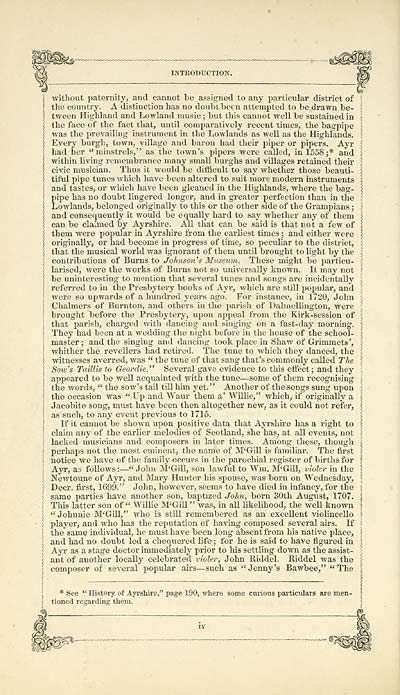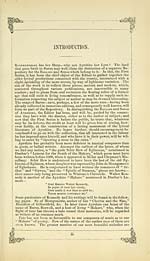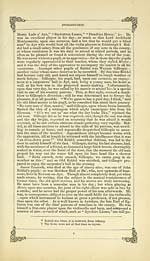Glen Collection of printed music > Printed text > Ballads and songs of Ayrshire > Volume 1
(10) Page iv
Download files
Complete book:
Complete section:
Individual page:
Thumbnail gallery: Grid view | List view

INTRODUCTION.
without paternity, and cannot be assigned to any particular district of
the country. A distinction has no doubt been attempted to be drawn be-
tween Highland and Lowland music ; but this cannot well be sustained in
the face of the fact that, until comparatively recent times, the bagpipe
was the prevailing instrument in the Lowlands as well as the Highlands.
Every burgh, town, village and baron had their piper or pipers. Ayr
had her "minstrels," as the town's pipers were called, in 1558;* and
within living remembrance many small burghs and villages retained their
civic musician. Thus it would be difficult to say whether those beauti-
tiful pipe tunes which have been altered to suit more modern instruments
and tastes, or winch have been gleaned in the Highlands, where the bag-
pipe has no doubt lingered longer, and in greater perfection than in the
Lowlands, belonged originally to this or the other side of the Grampians ;
and consequently it would be equally hard to say whether any of them
can be claimed by Ayrshire. All that can be said is that not a few of
them were popular in Ayrshire from the earliest times ; and either were
originally, or had become in progress of time, so peculiar to the district,
that the musical world was ignorant of them until brought to light by the
contributions of Burns to Johnson's Museum. These might be particu-
larised, were the works of Burns not so universally known. It may not
be uninteresting to mention that several tunes and songs are incidentally
referred to in the Presbytery books of Ayr, which are still popular, and
were so upwards of a hundred years ago. For instance, in 1720, John
Chalmers of Burnton, and others in the parish of Dalmellington, were
brought before the Presbytery, upon appeal from the Kirk-session of
that parish, charged with dancing and singing on a fast-day morning.
They had been at a wedding the night before in the house of the school-
master ; and the singing and dancing took place in Shaw of Grimmets',
whither the revellers had retired. The tune to which they danced, the
witnesses averred, was " the tune of that sang that's commonly called The
Soiu's Taillis to Geordie." Several gave evidence to this effect; and they
appeared to be well acquainted with the tune — some of them recognising
the words, " the sow's tail till him yet." Another of the songs sung upon
the occasion was " Up and Waur them a' Willie," which, if originally a
Jacobite song, must have been then altogether new, as it could not refer,
as such, to any event previous to 1715.
If it cannot be shown upon positive data that Ayrshire has a right to
claim any of the earlier melodies of Scotland, she has, at all events, not
lacked musicians and composers in later times. Among these, though
perhaps not the most eminent, the name of M'Gill is familiar. The first
notice we have of the family occurs in the parochial register of births for I
Ayr, as foUows : — " John M'Gill, son lawful to Wm. M'Gill, violer in the I
Newtoune of Ayr, and Mary Hunter his spouse, was born on Wednesday, I
Deer, fii'st, 1699." John, however, seems to have died in infancy, for the \
same parties have another son, baptized Johii, born 30th August, 1707. |
This latter son of " Willie M'Gill " was, in all likelihood, the well known I
"Johnnie M'Gill," who is still remembered as an excellent violincello i
player, and who has the reputation of having composed several airs. If i
the same individual, he must have been long absent from his native place, i
and had no doubt led a chequered life ; for he is said to have figured in \
Ayr as a stage doctor immediately prior to his settling down as the assist-
ant of another locallj^ celebrated violer, John Riddel. Riddel was the
composer of several popular airs — such as "Jenny's Bawbee," "The
* See " History of Ayrshire," page 190, where some ciuioiis particulars are men-
tioned regarding them.
without paternity, and cannot be assigned to any particular district of
the country. A distinction has no doubt been attempted to be drawn be-
tween Highland and Lowland music ; but this cannot well be sustained in
the face of the fact that, until comparatively recent times, the bagpipe
was the prevailing instrument in the Lowlands as well as the Highlands.
Every burgh, town, village and baron had their piper or pipers. Ayr
had her "minstrels," as the town's pipers were called, in 1558;* and
within living remembrance many small burghs and villages retained their
civic musician. Thus it would be difficult to say whether those beauti-
tiful pipe tunes which have been altered to suit more modern instruments
and tastes, or winch have been gleaned in the Highlands, where the bag-
pipe has no doubt lingered longer, and in greater perfection than in the
Lowlands, belonged originally to this or the other side of the Grampians ;
and consequently it would be equally hard to say whether any of them
can be claimed by Ayrshire. All that can be said is that not a few of
them were popular in Ayrshire from the earliest times ; and either were
originally, or had become in progress of time, so peculiar to the district,
that the musical world was ignorant of them until brought to light by the
contributions of Burns to Johnson's Museum. These might be particu-
larised, were the works of Burns not so universally known. It may not
be uninteresting to mention that several tunes and songs are incidentally
referred to in the Presbytery books of Ayr, which are still popular, and
were so upwards of a hundred years ago. For instance, in 1720, John
Chalmers of Burnton, and others in the parish of Dalmellington, were
brought before the Presbytery, upon appeal from the Kirk-session of
that parish, charged with dancing and singing on a fast-day morning.
They had been at a wedding the night before in the house of the school-
master ; and the singing and dancing took place in Shaw of Grimmets',
whither the revellers had retired. The tune to which they danced, the
witnesses averred, was " the tune of that sang that's commonly called The
Soiu's Taillis to Geordie." Several gave evidence to this effect; and they
appeared to be well acquainted with the tune — some of them recognising
the words, " the sow's tail till him yet." Another of the songs sung upon
the occasion was " Up and Waur them a' Willie," which, if originally a
Jacobite song, must have been then altogether new, as it could not refer,
as such, to any event previous to 1715.
If it cannot be shown upon positive data that Ayrshire has a right to
claim any of the earlier melodies of Scotland, she has, at all events, not
lacked musicians and composers in later times. Among these, though
perhaps not the most eminent, the name of M'Gill is familiar. The first
notice we have of the family occurs in the parochial register of births for I
Ayr, as foUows : — " John M'Gill, son lawful to Wm. M'Gill, violer in the I
Newtoune of Ayr, and Mary Hunter his spouse, was born on Wednesday, I
Deer, fii'st, 1699." John, however, seems to have died in infancy, for the \
same parties have another son, baptized Johii, born 30th August, 1707. |
This latter son of " Willie M'Gill " was, in all likelihood, the well known I
"Johnnie M'Gill," who is still remembered as an excellent violincello i
player, and who has the reputation of having composed several airs. If i
the same individual, he must have been long absent from his native place, i
and had no doubt led a chequered life ; for he is said to have figured in \
Ayr as a stage doctor immediately prior to his settling down as the assist-
ant of another locallj^ celebrated violer, John Riddel. Riddel was the
composer of several popular airs — such as "Jenny's Bawbee," "The
* See " History of Ayrshire," page 190, where some ciuioiis particulars are men-
tioned regarding them.
Set display mode to: Large image | Transcription
Images and transcriptions on this page, including medium image downloads, may be used under the Creative Commons Attribution 4.0 International Licence unless otherwise stated. ![]()
| Special collections of printed music > Glen Collection of printed music > Printed text > Ballads and songs of Ayrshire > Volume 1 > (10) Page iv |
|---|
| Permanent URL | https://digital.nls.uk/91252350 |
|---|
| Shelfmark | Glen.205(1) |
|---|---|
| Additional NLS resources: | |
| Description | Illustrated with sketches, historical, traditional, narrative and biographical |
|---|---|
| Shelfmark | Glen.205(1-2) |
| Additional NLS resources: | |
| Attribution and copyright: |
|
| Description | Scottish songs and music of the 18th and early 19th centuries, including music for the Highland bagpipe. These are selected items from the collection of John Glen (1833 to 1904). Also includes a few manuscripts, some treatises, and other books on the subject. |
|---|
| Description | The Glen Collection and the Inglis Collection represent mainly 18th and 19th century Scottish music, including Scottish songs. The collections of Berlioz and Verdi collected by bibliographer Cecil Hopkinson contain contemporary and later editions of the works of the two composers Berlioz and Verdi. |
|---|

